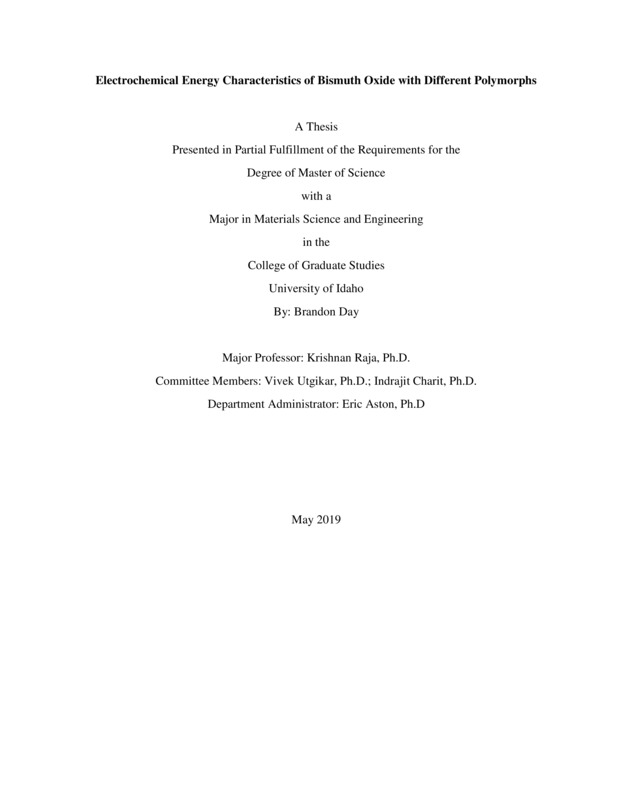Electrochemical Energy Characteristics of Bismuth Oxide with Different Polymorphs
Day, Brandon C. (2019-05). Electrochemical Energy Characteristics of Bismuth Oxide with Different Polymorphs. Theses and Dissertations Collection, University of Idaho Library Digital Collections. https://www.lib.uidaho.edu/digital/etd/items/day_idaho_0089n_11591.html
- Title:
- Electrochemical Energy Characteristics of Bismuth Oxide with Different Polymorphs
- Author:
- Day, Brandon C
- ORCID:
- Bran-don-Day
- Date:
- 2019-05
- Embargo Remove Date:
- 2021-07-10
- Program:
- Chemical and Materials Science Engineering
- Subject Category:
- Materials Science
- Abstract:
-
Bismuth sesquioxide (Bi2O3) is a potential material to be used for supercapacitors. Bi2O3 has a theoretical capacitance of 1305 F/g. However, this value has yet to be obtained in actual experimental procedures. In this study research was done on two of the five different polymorphs that exist. These phases were the α (monoclinic) and ß (tetragonal) structures. Additionally, a third structure chrombismite (Bi16CrO27) electrochemical performance was tested. Nucleation behavior of α and ß material was determined by running galvanostatic experiments at a current density of 7.885 mA/cm2 for varying time intervals of 10 seconds, 30 seconds, 1 minute, then 5 minutes on a glassy carbon substrate. Afterward, each sample was viewed using scanning electron microscope to see how the Bi2O3 deposited on the surface. It was seen with the short time intervals that island growth or spontaneous nucleation occurred. Over longer periods of time the islands eventually grew to form platelets on the substrate. X-ray diffraction (XRD)was performed on the samples with a thicker deposit to determine if they went on in the proper crystalline phase. From reviewing the graphs, the structures showed a few broad peaks, symbolizing that it was only semi-crystalline after deposition was completed.
Once nucleation behavior was determined, to obtain the true phase of each deposition they were annealed in a box furnace for 2 hours. α phase is achieved by annealing at 500° C while ß phase and chrombismite structure are done at 400° C. As deposited and annealed samples were electrochemical performance was determined using EIS, Mott Schottky, and cyclic charge discharge experiments. Each sample was compared to one another and it was determined that the as deposited chombismite material showed the most promise as a supercapacitor. Its capacitance was 361 Fg-1 at a current load of 1 mA and showed no material degradation after 20 charge discharge cycles.
- Description:
- masters, M.Engr., Chemical and Materials Science Engineering -- University of Idaho - College of Graduate Studies, 2019-05
- Major Professor:
- Raja, Krishnan
- Committee:
- Utgikar, Vivek; Charit, Indrajit
- Defense Date:
- 2019-05
- Identifier:
- Day_idaho_0089N_11591
- Type:
- Text
- Format Original:
- Format:
- application/pdf
- Rights:
- In Copyright - Educational Use Permitted. For more information, please contact University of Idaho Library Special Collections and Archives Department at libspec@uidaho.edu.
- Standardized Rights:
- http://rightsstatements.org/vocab/InC-EDU/1.0/

